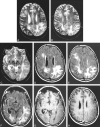Cerebral amyloid angiopathy presenting as nonhemorrhagic diffuse encephalopathy: neuropathologic and neuroradiologic manifestations in one case
- PMID: 11415900
- PMCID: PMC7974807
Cerebral amyloid angiopathy presenting as nonhemorrhagic diffuse encephalopathy: neuropathologic and neuroradiologic manifestations in one case
Abstract
A case of cerebral amyloid angiopathy is presented with MR imaging findings of high intense signal on T2-weighted sequences at the level of the white and gray matter of both hemispheres in the absence of neuroradiologic signs of cerebral hemorrhage. The biopsy specimen revealed deposition of amyloid in the walls of the intracranial arterial branches and focal ischemic changes and gliosis in the gray and white matter. We consider this presentation to be very unusual in patients affected by cerebral amyloid angiopathy.
Figures



Similar articles
-
Encephalopathy with amyloid angiopathy and numerous amyloid plaques with low levels of CSF Aβ1-40/Aβ1-42.Amyloid. 2012 Dec;19(4):186-90. doi: 10.3109/13506129.2012.725113. Epub 2012 Sep 21. Amyloid. 2012. PMID: 22994303
-
Cerebral amyloid angiopathy mimicking central nervous system metastases: a case report.J Med Case Rep. 2018 May 14;12(1):133. doi: 10.1186/s13256-018-1655-6. J Med Case Rep. 2018. PMID: 29754590 Free PMC article.
-
Spontaneous intracerebral hemorrhage secondary to cerebral amyloid angiopathy.J Am Geriatr Soc. 2009 Sep;57(9):1714-6. doi: 10.1111/j.1532-5415.2009.02403.x. J Am Geriatr Soc. 2009. PMID: 19895438 No abstract available.
-
[Cerebral amyloid angiopathy].Psychol Neuropsychiatr Vieil. 2007 Mar;5(1):35-45. Psychol Neuropsychiatr Vieil. 2007. PMID: 17412664 Review. French.
-
The Inflammatory Form of Cerebral Amyloid Angiopathy or "Cerebral Amyloid Angiopathy-Related Inflammation" (CAARI).Curr Neurol Neurosci Rep. 2015 Aug;15(8):54. doi: 10.1007/s11910-015-0572-y. Curr Neurol Neurosci Rep. 2015. PMID: 26096511 Review.
Cited by
-
When Atrial Fibrillation Meets Cerebral Amyloid Angiopathy: Current Evidence and Strategies.J Clin Med. 2023 Dec 15;12(24):7704. doi: 10.3390/jcm12247704. J Clin Med. 2023. PMID: 38137773 Free PMC article. Review.
-
Pseudotumoral Presentation of Cerebral Amyloid-Beta Angiopathy: Case Report and Review of Literature.Psychiatry Investig. 2021 Jun;18(6):479-485. doi: 10.30773/pi.2020.0201. Epub 2021 Jun 17. Psychiatry Investig. 2021. PMID: 34130443 Free PMC article.
References
-
- Oppenheimen G. Uber drusige nekrozen in der grosshirnrinde. Neurol Centralbi 1909;28:410-413
-
- Bruni J, Bilbao JM, Pritzker KP. Vascular amyloid in the aging CNS: clinicopathological study and literature review. Can J Neurol Sci 1977;4:239-244 - PubMed
-
- Vanley CT, Aguilar MJ, Kleinhenz RJ, Lagios MD. Cerebral amyloid angiopathy. Hum Pathol 1981;12:609-619 - PubMed
-
- Okazaki H, Reagan TJ, Campbell RJ. Clinicopathological studies of primary cerebral amyloid angiopathy. Mayo Clin Proc 1979;54:22-31 - PubMed
-
- Cohen M, Lanska D. Amyloidoma of the CNS: I. clinical and pathologic study. Neurology 1992;42:2019-2023 - PubMed
Publication types
MeSH terms
LinkOut - more resources
Full Text Sources
Medical
